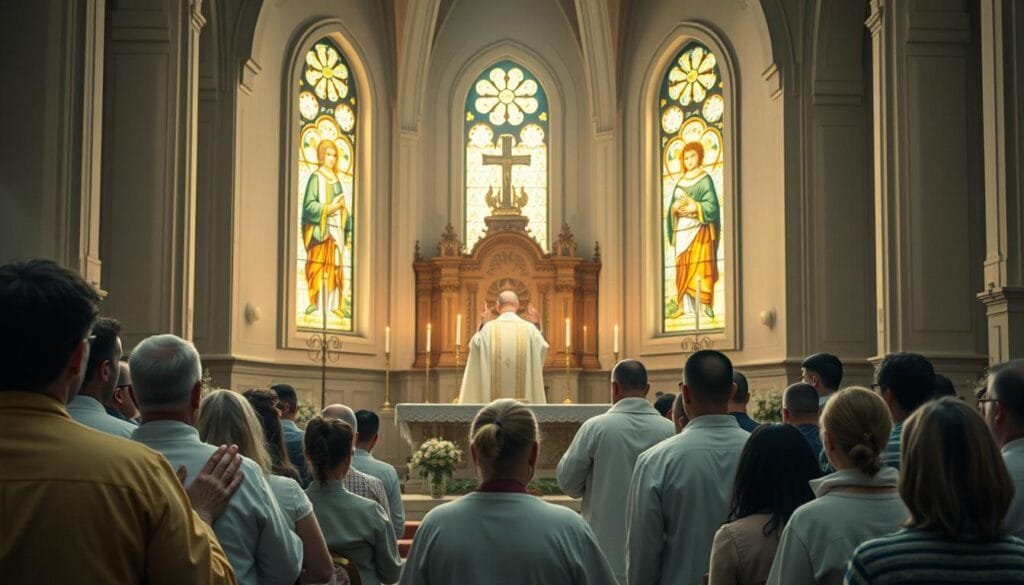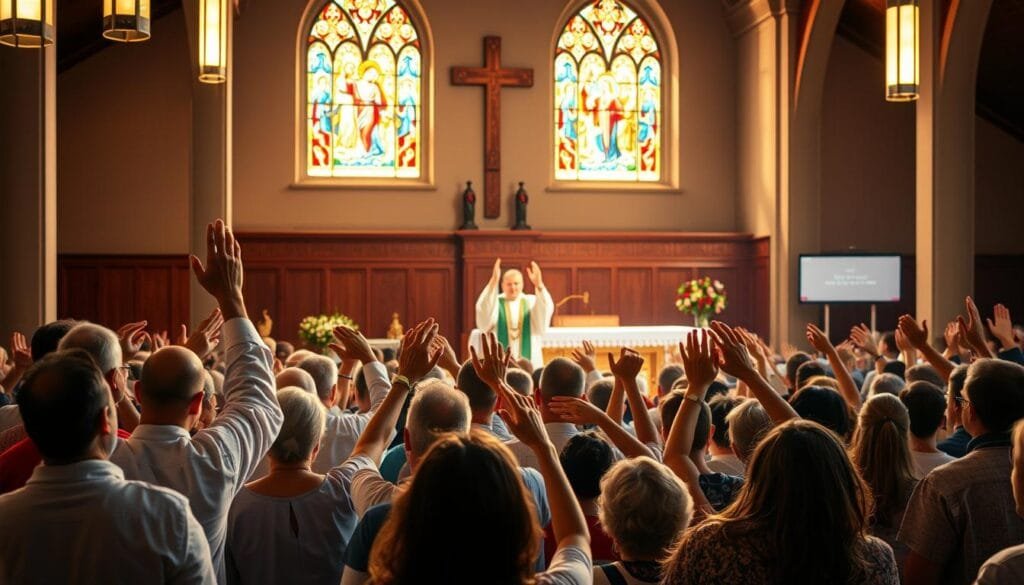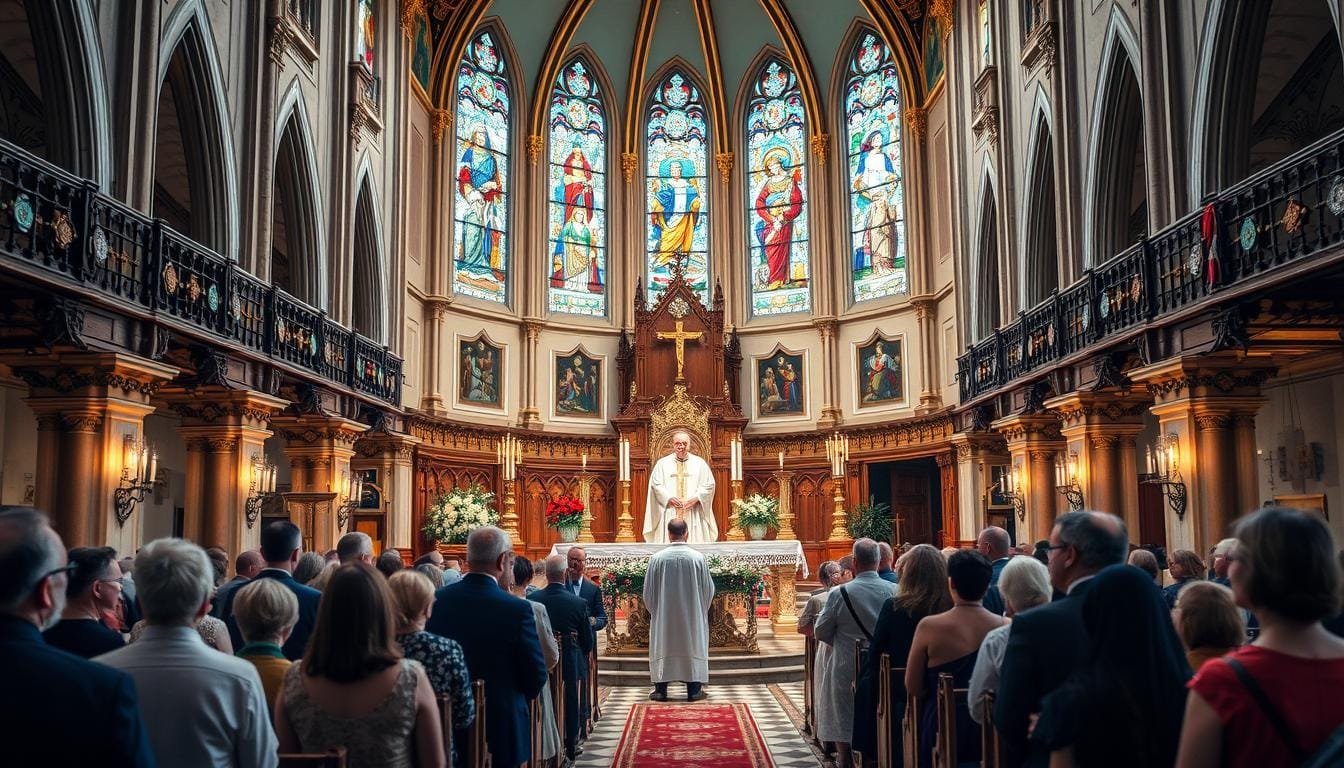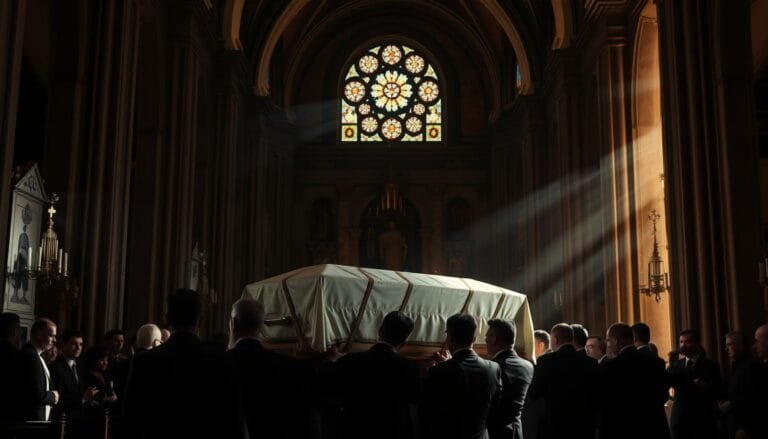Understanding The Catholic Mass
This website contains affiliate links. As an Amazon Associate, I earn from qualifying purchases. The content on this website was created with the help of AI.
Children who attend regular Children’s Liturgy often feel more connected to their faith. This shows how important tailored worship is for young believers.
Let’s explore the Catholic Mass and its rich traditions.
The Catholic Mass is the heart of Catholic worship. It brings believers together to commune with God and each other. This sacred ritual combines prayer, Scripture, and sacrament.
The Mass has two main parts: the Liturgy of the Word and the Liturgy of the Eucharist. Each part plays a key role in nurturing faith.
They connect us to God’s presence through Scripture, prayer, and sacred tradition.
We’ll examine the parts of the Mass and their historical importance. You’ll learn how taking part can enrich your spiritual life. This guide will help in understanding the Catholic Mass.
Key Takeaways
- The Catholic Mass is divided into the Liturgy of the Word and the Liturgy of the Eucharist
- Mass follows a three-year cycle of readings, covering a significant portion of the Bible
- The Eucharist is the central sacrament celebrated during Mass
- Active participation enhances the spiritual experience of Mass
- Understanding the structure and symbolism of Mass deepens one’s faith journey
The Sacred Nature of Catholic Mass
The Catholic Mass holds a special place in Catholic history. We believe in the divine presence during this sacred ceremony.
It’s a profound spiritual experience connecting us to centuries-old traditions.
The Divine Presence in Mass
At the heart of Catholic Mass is the belief in transubstantiation. During the Eucharist, the bread and wine become Christ’s body and blood.
This divine presence is central to our faith and worship.
Historical Significance of the Mass
Catholic Mass traces back to the Last Supper. It has evolved while keeping its core elements. Pope Paul VI established the current form in 1969, reflecting continuity and change.
Role of Sacred Tradition
Sacred tradition shapes the Mass, guiding our practices and prayers through generations. It keeps the Mass a living link to our past. This tradition also serves our present spiritual needs.
| Element | Description | Significance |
|---|---|---|
| Gloria | Hymn of praise | Sung on Sundays and solemnities |
| Scripture Readings | Old and New Testament | Three readings on Sundays |
| Eucharistic Prayer | Heart of the Liturgy | Re-presents Christ’s sacrifice |
The Mass blends ancient traditions with living faith. It connects us to the divine presence uniquely. This sacred ceremony offers a profound spiritual experience for Catholics worldwide.
Understanding The Catholic Mass: Essential Elements
The Catholic Mass is the core of Catholic worship. It’s a sacred ritual with several key parts. Let’s explore the Mass structure and its vital liturgical elements.
The Mass starts with Introductory Rites, setting the worship tone. Next is the Liturgy of the Word, featuring Scripture readings and a homily.
The Liturgy of the Eucharist follows, leading to Holy Communion.
The Concluding Rites end the Mass, sending us to live our faith. Each part serves a unique purpose in our worship. The Catholic worship components create a full celebration of faith.
Prayers, hymns, rituals, and the Eucharist all hold deep meaning. Every element works together in this comprehensive faith celebration.
“The Catholic Church teaches that the Mass is the ‘source and summit of the Christian life.'”
Let’s look at some key stats about the Catholic Mass:
| Element | Description |
|---|---|
| Essential Components | Priest, victim, altar, and sacrifice |
| Sunday Mass Inclusions | Prayers, hymns, Bible readings, sermon, Eucharist |
| Symbolic Categories | Creation, human culture, Old Testament, Christ’s mission |
| Liturgy of the Word Readings | Old Testament, Epistles, Gospels |
| Lectionary Cycle | Three-year cycle for Sundays, two-year for weekdays |
These elements show the depth of the Catholic Mass. It’s a centuries-old tradition that remains vibrant today. By taking part, we join in this meaningful celebration.
The Liturgy of the Word
The Liturgy of the Word is a vital part of Catholic Mass. We gather to hear God’s message through scripture readings.
This section follows a structured format, helping us reflect on biblical passages.
First Reading and Responsorial Psalm
The journey begins with the first reading, usually from the Old Testament. It sets the day’s theme. Next, we join in the Responsorial Psalm, a musical reflection on the first reading.
Second Reading and Gospel Acclamation
The second reading comes from the New Testament letters. It often guides Christian living. The Gospel Acclamation follows, preparing our hearts for the main scripture.
The Gospel Reading and Homily
The Gospel reading is the highlight of the Liturgy of the Word. It’s read by the priest or deacon with special reverence. The homily helps us understand and apply the readings to our lives.
| Element | Source | Purpose |
|---|---|---|
| First Reading | Old Testament | Introduce theme |
| Second Reading | New Testament Letters | Provide guidance |
| Gospel | Matthew, Mark, Luke, or John | Present Christ’s words and deeds |
| Homily | Priest’s reflection | Apply scriptures to life |
The Liturgy of the Word calls us to listen actively to God’s message. It’s a time to think about sharing Christ’s love through our actions.
We can carry this message beyond the Mass into our daily lives.
The Liturgy of the Eucharist
The Liturgy of the Eucharist is the core of Catholic Mass. This sacred rite includes three key elements that bring us closer to Christ.
Preparation of the Gifts
Families offer bread, wine, and financial contributions during this stage. These gifts represent our commitment to God’s earthly work.

The Eucharistic Prayer
The priest transforms bread and wine into Christ’s Body and Blood. This miraculous change is the highlight of our Eucharistic celebration.
We respond with “Amen,” confirming our belief in this divine transformation.
Holy Communion
The consecrated Eucharist is distributed to the faithful. We say “Amen” as we receive, recognizing the profound mystery we join.
This sacrament empowers us to follow God’s will. It symbolizes Christ’s loving embrace of His Church.
| Element | Significance |
|---|---|
| Preparation of Gifts | Symbolic offering of our lives to God |
| Eucharistic Prayer | Consecration and transubstantiation |
| Holy Communion | Receiving the Body and Blood of Christ |
The Eucharist is a powerful, intimate sacrament celebrated in every Mass worldwide. It feeds our souls and strengthens our bond with Christ and His Church.
Symbols and Rituals in Catholic Mass
Catholic Mass is filled with meaningful symbols and sacred rituals. These elements enrich our spiritual journey from the moment we enter the church.
They carry deep significance throughout the entire service.
Many Catholics dip their hand in holy water upon entering. They make the sign of the cross, recalling their baptism. Near the altar, people often genuflect or bow to honor Christ’s presence.
During Mass, we use various liturgical gestures. We stand attentively for God’s word and kneel reverently during the Eucharistic Prayer.
Priest’s vestments hold symbolic meaning, representing Christ’s authority and service.
Sacred objects play key roles in Mass rituals. The altar symbolizes Jesus himself. It’s where bread and wine become Christ’s Body and Blood. The paschal candle represents the Risen Christ.
“The use of incense in Catholic Mass symbolizes prayers rising up to God, creating a sensory connection between earthly worship and heavenly realities.”
Catholic symbolism includes visual representations too. The Chi Rho symbol, made from the Greek letters X and P, represents Christ.
The IHS monogram, from Jesus’ Greek name, is another common church symbol.
| Symbol | Meaning | Use in Mass |
|---|---|---|
| Holy Water | Purification and Baptism | Entrance Ritual |
| Incense | Rising Prayers | Liturgy of the Eucharist |
| Paschal Candle | Risen Christ | Easter Vigil and Baptisms |
| Chrism Oil | Gift of the Holy Spirit | Sacraments and Consecrations |
These symbols and rituals create a rich tapestry of faith. They connect us to centuries of tradition. They deepen our understanding of the sacred mysteries we celebrate in Mass.
Active Participation in the Mass
Catholic Mass calls for full engagement in worship. It’s about being present in mind, body, and spirit. Our participation goes beyond just showing up.
Physical Gestures and Responses
We stand, kneel, and sit at specific times during Mass. These acts connect us to the sacred. They’re more than just tradition.
The sign of the cross and other gestures deepen our involvement. These liturgical responses help us engage more fully.

Prayer and Meditation
Communal prayer is at the heart of Mass. We join in praise, petition, and thanksgiving together. Silent moments allow for personal reflection.
These quiet times help us bond with God and fellow worshippers. They foster a deeper spiritual connection.
Communal Worship Experience
Mass is not a spectator event. It’s a shared journey of faith. Our active participation makes the liturgy a vibrant community expression.
By fully engaging, we enhance our Mass attendance. This involvement also aids our spiritual growth.
“Full, conscious, and active participation in liturgical celebrations is demanded by the very nature of the liturgy.”
This Vatican II statement highlights the importance of our involvement. It reminds us that participation is both our right and duty.
Active participation opens us to receive the full graces of Mass. It allows us to fully experience the beauty of Catholic worship.
Special Celebrations Throughout the Liturgical Year
The Catholic liturgical calendar is full of seasonal celebrations. These special times guide our faith journey. They deepen our bond with Christ and the Church.
Advent and Christmas Masses
Advent starts our liturgical year. It’s a joyful wait for Christ’s birth. We light Advent wreath candles and sing “O Come, O Come Emmanuel”.
Christmas fills churches with nativity scenes and carols. The warmth of the community surrounds us during this season.
Lenten and Easter Celebrations
Lent calls us to reflect and renew. We fast, pray and give alms for 40 days. Holy Week leads us through Christ’s passion.
Easter Sunday brings joy. The Easter season lasts 50 days. We celebrate new life and hope.
Feast Days and Solemnities
We honor saints and key Church events year-round. These holy days remind us of our rich heritage. They call us to holiness.
Some feast days are so important they’re called solemnities. These mark the most significant events in our faith.
| Liturgical Season | Duration | Key Celebrations |
|---|---|---|
| Advent | 4 weeks | Immaculate Conception |
| Christmas | 12 days | Nativity, Epiphany |
| Lent | 40 days | Ash Wednesday, Palm Sunday |
| Easter | 50 days | Easter Sunday, Pentecost |
| Ordinary Time | 33-34 weeks | Various Saint Feast Days |
Our liturgical year shapes our daily faith. It’s a cycle of grace. We grow closer to God and each other through worship and celebration.
Conclusion
The Catholic Mass is a powerful path for spiritual growth. It’s rooted in ancient tradition and brings us closer to God. Each part of the Mass, from Word to Eucharist, deepens our connection with God and others.
The Mass begins with “In the name of the Father…” and ends with “Go in peace.” “Mass” comes from “missa,” meaning “to go” or “to be sent.”
This reflects Christ’s call to share our faith beyond church walls.
Mass isn’t a spectator sport. It’s active participation in divine mystery. We stand, sit, and kneel together, fully engaged in worship.
Every Mass offers a chance for transformation. This includes Sunday celebrations with three readings and weekday Masses. Let’s carry the peace and joy from Mass into our daily lives.
By doing so, we nurture our spiritual growth. We also strengthen our faith community. The Mass continues to shape us long after we leave the church.









